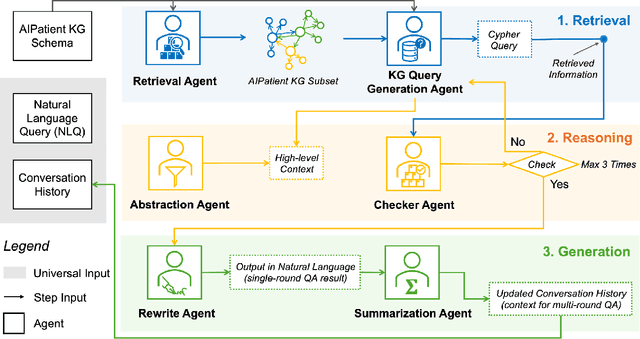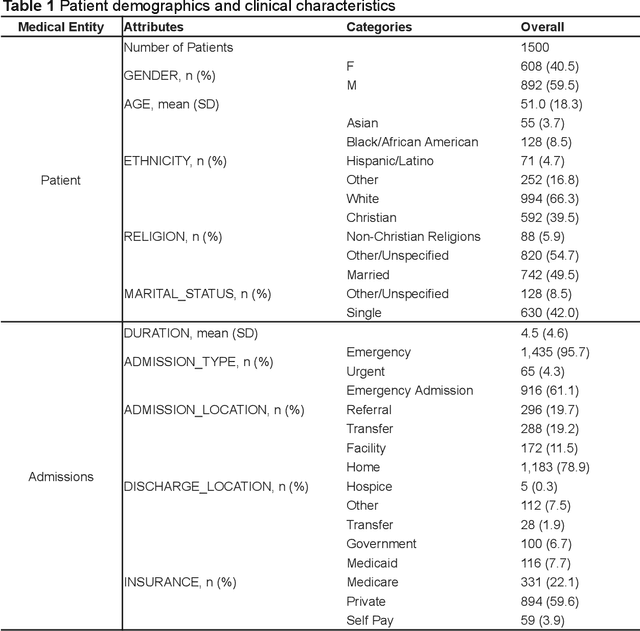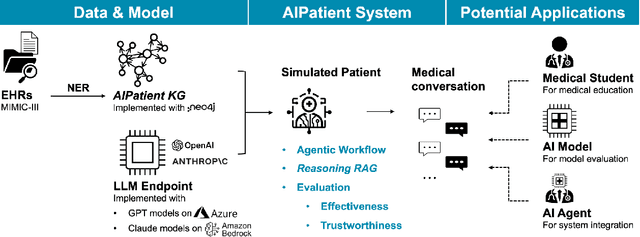Wenyue Hua
REALM: A Dataset of Real-World LLM Use Cases
Mar 24, 2025Abstract:Large Language Models, such as the GPT series, have driven significant industrial applications, leading to economic and societal transformations. However, a comprehensive understanding of their real-world applications remains limited. To address this, we introduce REALM, a dataset of over 94,000 LLM use cases collected from Reddit and news articles. REALM captures two key dimensions: the diverse applications of LLMs and the demographics of their users. It categorizes LLM applications and explores how users' occupations relate to the types of applications they use. By integrating real-world data, REALM offers insights into LLM adoption across different domains, providing a foundation for future research on their evolving societal roles. A dedicated dashboard https://realm-e7682.web.app/ presents the data.
AgentOrca: A Dual-System Framework to Evaluate Language Agents on Operational Routine and Constraint Adherence
Mar 11, 2025Abstract:As language agents progressively automate critical tasks across domains, their ability to operate within operational constraints and safety protocols becomes essential. While extensive research has demonstrated these agents' effectiveness in downstream task completion, their reliability in following operational procedures and constraints remains largely unexplored. To this end, we present AgentOrca, a dual-system framework for evaluating language agents' compliance with operational constraints and routines. Our framework encodes action constraints and routines through both natural language prompts for agents and corresponding executable code serving as ground truth for automated verification. Through an automated pipeline of test case generation and evaluation across five real-world domains, we quantitatively assess current language agents' adherence to operational constraints. Our findings reveal notable performance gaps among state-of-the-art models, with large reasoning models like o1 demonstrating superior compliance while others show significantly lower performance, particularly when encountering complex constraints or user persuasion attempts.
InductionBench: LLMs Fail in the Simplest Complexity Class
Feb 26, 2025Abstract:Large language models (LLMs) have shown remarkable improvements in reasoning and many existing benchmarks have been addressed by models such as o1 and o3 either fully or partially. However, a majority of these benchmarks emphasize deductive reasoning, including mathematical and coding tasks in which rules such as mathematical axioms or programming syntax are clearly defined, based on which LLMs can plan and apply these rules to arrive at a solution. In contrast, inductive reasoning, where one infers the underlying rules from observed data, remains less explored. Such inductive processes lie at the heart of scientific discovery, as they enable researchers to extract general principles from empirical observations. To assess whether LLMs possess this capacity, we introduce InductionBench, a new benchmark designed to evaluate the inductive reasoning ability of LLMs. Our experimental findings reveal that even the most advanced models available struggle to master the simplest complexity classes within the subregular hierarchy of functions, highlighting a notable deficiency in current LLMs' inductive reasoning capabilities. Coda and data are available https://github.com/Wenyueh/inductive_reasoning_benchmark.
Towards a Design Guideline for RPA Evaluation: A Survey of Large Language Model-Based Role-Playing Agents
Feb 18, 2025Abstract:Role-Playing Agent (RPA) is an increasingly popular type of LLM Agent that simulates human-like behaviors in a variety of tasks. However, evaluating RPAs is challenging due to diverse task requirements and agent designs. This paper proposes an evidence-based, actionable, and generalizable evaluation design guideline for LLM-based RPA by systematically reviewing 1,676 papers published between Jan. 2021 and Dec. 2024. Our analysis identifies six agent attributes, seven task attributes, and seven evaluation metrics from existing literature. Based on these findings, we present an RPA evaluation design guideline to help researchers develop more systematic and consistent evaluation methods.
ADO: Automatic Data Optimization for Inputs in LLM Prompts
Feb 17, 2025Abstract:This study explores a novel approach to enhance the performance of Large Language Models (LLMs) through the optimization of input data within prompts. While previous research has primarily focused on refining instruction components and augmenting input data with in-context examples, our work investigates the potential benefits of optimizing the input data itself. We introduce a two-pronged strategy for input data optimization: content engineering and structural reformulation. Content engineering involves imputing missing values, removing irrelevant attributes, and enriching profiles by generating additional information inferred from existing attributes. Subsequent to content engineering, structural reformulation is applied to optimize the presentation of the modified content to LLMs, given their sensitivity to input format. Our findings suggest that these optimizations can significantly improve the performance of LLMs in various tasks, offering a promising avenue for future research in prompt engineering. The source code is available at https://anonymous.4open.science/r/ADO-6BC5/
Layer-Level Self-Exposure and Patch: Affirmative Token Mitigation for Jailbreak Attack Defense
Jan 05, 2025Abstract:As large language models (LLMs) are increasingly deployed in diverse applications, including chatbot assistants and code generation, aligning their behavior with safety and ethical standards has become paramount. However, jailbreak attacks, which exploit vulnerabilities to elicit unintended or harmful outputs, threaten LLMs' safety significantly. In this paper, we introduce Layer-AdvPatcher, a novel methodology designed to defend against jailbreak attacks by utilizing an unlearning strategy to patch specific layers within LLMs through self-augmented datasets. Our insight is that certain layer(s), tend to produce affirmative tokens when faced with harmful prompts. By identifying these layers and adversarially exposing them to generate more harmful data, one can understand their inherent and diverse vulnerabilities to attacks. With these exposures, we then "unlearn" these issues, reducing the impact of affirmative tokens and hence minimizing jailbreak risks while keeping the model's responses to safe queries intact. We conduct extensive experiments on two models, four benchmark datasets, and multiple state-of-the-art jailbreak benchmarks to demonstrate the efficacy of our approach. Results indicate that our framework reduces the harmfulness and attack success rate of jailbreak attacks without compromising utility for benign queries compared to recent defense methods.
RuleArena: A Benchmark for Rule-Guided Reasoning with LLMs in Real-World Scenarios
Dec 12, 2024



Abstract:This paper introduces RuleArena, a novel and challenging benchmark designed to evaluate the ability of large language models (LLMs) to follow complex, real-world rules in reasoning. Covering three practical domains -- airline baggage fees, NBA transactions, and tax regulations -- RuleArena assesses LLMs' proficiency in handling intricate natural language instructions that demand long-context understanding, logical reasoning, and accurate mathematical computation. Two key attributes distinguish RuleArena from traditional rule-based reasoning benchmarks: (1) it extends beyond standard first-order logic representations, and (2) it is grounded in authentic, practical scenarios, providing insights into the suitability and reliability of LLMs for real-world applications. Our findings reveal several notable limitations in LLMs: (1) they struggle to identify and apply the appropriate rules, frequently becoming confused by similar but distinct regulations, (2) they cannot consistently perform accurate mathematical computations, even when they correctly identify the relevant rules, and (3) in general, they perform poorly in the benchmark. These results highlight significant challenges in advancing LLMs' rule-guided reasoning capabilities in real-life applications.
Disentangling Memory and Reasoning Ability in Large Language Models
Nov 21, 2024Abstract:Large Language Models (LLMs) have demonstrated strong performance in handling complex tasks requiring both extensive knowledge and reasoning abilities. However, the existing LLM inference pipeline operates as an opaque process without explicit separation between knowledge retrieval and reasoning steps, making the model's decision-making process unclear and disorganized. This ambiguity can lead to issues such as hallucinations and knowledge forgetting, which significantly impact the reliability of LLMs in high-stakes domains. In this paper, we propose a new inference paradigm that decomposes the complex inference process into two distinct and clear actions: (1) memory recall: which retrieves relevant knowledge, and (2) reasoning: which performs logical steps based on the recalled knowledge. To facilitate this decomposition, we introduce two special tokens memory and reason, guiding the model to distinguish between steps that require knowledge retrieval and those that involve reasoning. Our experiment results show that this decomposition not only improves model performance but also enhances the interpretability of the inference process, enabling users to identify sources of error and refine model responses effectively. The code is available at https://github.com/MingyuJ666/Disentangling-Memory-and-Reasoning.
Game-theoretic LLM: Agent Workflow for Negotiation Games
Nov 12, 2024



Abstract:This paper investigates the rationality of large language models (LLMs) in strategic decision-making contexts, specifically within the framework of game theory. We evaluate several state-of-the-art LLMs across a spectrum of complete-information and incomplete-information games. Our findings reveal that LLMs frequently deviate from rational strategies, particularly as the complexity of the game increases with larger payoff matrices or deeper sequential trees. To address these limitations, we design multiple game-theoretic workflows that guide the reasoning and decision-making processes of LLMs. These workflows aim to enhance the models' ability to compute Nash Equilibria and make rational choices, even under conditions of uncertainty and incomplete information. Experimental results demonstrate that the adoption of these workflows significantly improves the rationality and robustness of LLMs in game-theoretic tasks. Specifically, with the workflow, LLMs exhibit marked improvements in identifying optimal strategies, achieving near-optimal allocations in negotiation scenarios, and reducing susceptibility to exploitation during negotiations. Furthermore, we explore the meta-strategic considerations of whether it is rational for agents to adopt such workflows, recognizing that the decision to use or forgo the workflow constitutes a game-theoretic issue in itself. Our research contributes to a deeper understanding of LLMs' decision-making capabilities in strategic contexts and provides insights into enhancing their rationality through structured workflows. The findings have implications for the development of more robust and strategically sound AI agents capable of navigating complex interactive environments. Code and data supporting this study are available at \url{https://github.com/Wenyueh/game_theory}.
AIPatient: Simulating Patients with EHRs and LLM Powered Agentic Workflow
Sep 27, 2024



Abstract:Simulated patient systems play a crucial role in modern medical education and research, providing safe, integrative learning environments and enabling clinical decision-making simulations. Large Language Models (LLM) could advance simulated patient systems by replicating medical conditions and patient-doctor interactions with high fidelity and low cost. However, ensuring the effectiveness and trustworthiness of these systems remains a challenge, as they require a large, diverse, and precise patient knowledgebase, along with a robust and stable knowledge diffusion to users. Here, we developed AIPatient, an advanced simulated patient system with AIPatient Knowledge Graph (AIPatient KG) as the input and the Reasoning Retrieval-Augmented Generation (Reasoning RAG) agentic workflow as the generation backbone. AIPatient KG samples data from Electronic Health Records (EHRs) in the Medical Information Mart for Intensive Care (MIMIC)-III database, producing a clinically diverse and relevant cohort of 1,495 patients with high knowledgebase validity (F1 0.89). Reasoning RAG leverages six LLM powered agents spanning tasks including retrieval, KG query generation, abstraction, checker, rewrite, and summarization. This agentic framework reaches an overall accuracy of 94.15% in EHR-based medical Question Answering (QA), outperforming benchmarks that use either no agent or only partial agent integration. Our system also presents high readability (median Flesch Reading Ease 77.23; median Flesch Kincaid Grade 5.6), robustness (ANOVA F-value 0.6126, p<0.1), and stability (ANOVA F-value 0.782, p<0.1). The promising performance of the AIPatient system highlights its potential to support a wide range of applications, including medical education, model evaluation, and system integration.
 Add to Chrome
Add to Chrome Add to Firefox
Add to Firefox Add to Edge
Add to Edge